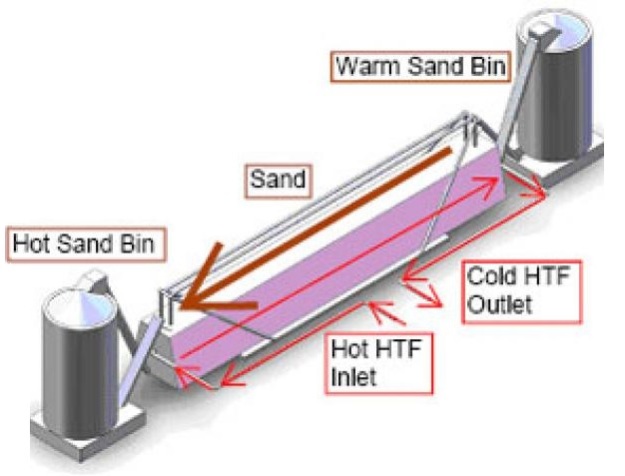Concentrated Solar Power (CSP) uses mirrors to reflect heat from the sun to one point, most typically the tow of a tower filler with a fluid (usually molten salt) capable of storing heat for prolonged periods then used to produce electricity.

Traditional Thermodynamic Solar Plant that concentrates sun light in the tow of the tower – photo from http://www.fotovoltaicosulweb.it
An alternative to the central tower is represented by curved mirrors concentrating the sun light in a suitable pipe that runs all the way from/to the storage accumulating heat while running in the plant.

An alternative to the central concentration tower – photo from http://www.strettoweb.com
In both cases, the molted salts are heated up to 600 degree Celsius and transferred in a hot storage.
The fluid so heated is used to produce high temperature/high pressure steam that is used to generate electricity by evolving in a steam turbine.
The main benefit of this technology is that energy is easily stored and can be used at night when the source of heat (the sun) is absent. However, the popular photovoltaic modules are currently more cost effective and therefore preferred over the concentrated solar power plants.
But now the situation can drastically change.
Masdar Institute of Science and Technology’s scientists, indeed, have published a breakthrough research into more efficient solar power plants by using sand as vector fluid to transport and store energy.
Named “Sandstock”, the research published at the Solar Power and Chemical Energy Systems Conference in South Africa in December 2015, showed sand can withstand temperatures of up to 1,000°C and the higher you can push the temperature, the more efficient the plant will be in generating electricity.
The approach chosen by the researchers at Masdar Institute completely eliminates the most expensive components of the traditional CSP, the molten fluid and the pump system, by substituting it with sand and gravity. The design concept, which is inspired by a traditional sand hourglass, features a ‘cold tank,’ where sand is initially stored – before flowing into a ‘hot tank,’ located directly underneath. The cold tank will take the form of a hollow cylinder, designed to allow the concentrated solar flux to penetrate an empty central cylinder part.

Schematic concept of the Sandstock design – photo from social.csptoday
“Sand is really always a drawback in this country but in this project we wanted to use it as an advantage because it can withstand very high temperature, and of course it is very cheap here,” said Dr Nicolas Calvet, assistant professor of mechanical and materials engineering, and guide for the research project, as also reported by The National.
“Photovoltaic is more popular because of more than 40 years of research, and the Chinese entering the market and driving prices down,” Dr Calvet said.
“If you want to make CSP more competitive you must significantly reduce the cost.”
The main costs for CSP are the reflective material, and whatever is used for heat transfer and storage. Dr Calvet and his students are using sand for the last two steps at almost no cost.
“When you build a CSP plant you need to import usually several thousand tonnes of molten salts from Chile,” he said.
“With this concept you can just build your plant in the desert and you don’t have to bring any other material, you have it on site.”
Dr Behjat Al Yousuf, interim provost at the Masdar Institute of Science and Technology, said: “The research success of the Sandstock project illustrates the strength of our research and its local relevance.”
